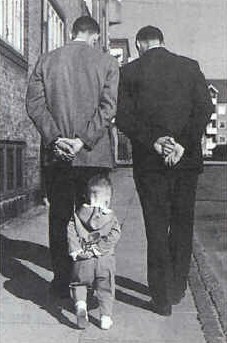No. 15 (2012): Imitation and Repetition

As concepts which cross the disciplinary boundaries between the arts and the social sciences, imitation and repetition are frequently connoted in ways dependant on the contexts and time periods in which they occur. This is reflected in the articles collected in issue 15 of FORUM which explore manifestations of imitation and repetition in contexts as diverse ascontemporary memoir-writing (Pollard), knowledge exchange within academia (Götz),the critical theory of Judith Butler (Vulic), Sherlock Holmes fanfiction (Black), Scottish avant-garde poetry (Matsumoto), the work of James Joyce (Raghinaru) and Chinese Qing dynasty cultural production (Zhang). For many of our contributors from the fields of Translation Studies, Sociology, Philosophy, English Literature and Art History the terms not only become a source of investigation but also provide an exciting methodological challenge, while for others, such as our guest contributor Robert King, the very logic inherent in the terms becomes an object of inquiry in itself.

In his article “The New Creatures of Difference: A Look at the Concept of Repetition Within Dissipative Systems Theory,”King draws on Deleuze’s concept of repetition Difference and Repetition as a seemingly “mechanical replication” which hides a “clothed, disguised or secret repetition” (King 2-3). An exploration of the presence of repetition in the life sciences thus reveals how even when returning to philosophical thought, “repetition is better appreciated as a creature of difference” (4). This “creature of difference” continues to creep and crawl its way through the articles of our postgraduate contributors in various guises. The relationship between repetition and evolution, for example, takes a more metaphorical turn in Ana Vulic’s examination of “the evolution of the theory of performativity” via the repeatedly occurring, yet subtly changing “notion of promise” in the work of Judith Butler (1). Here King’s “creatures of difference” reappear reclothed as the “infelicitous” misfires Vulic identifies as creative differences bearing political promise.
While the occurrence of “misfires” in the intertextual relations surrounding the work of Judith Butler are the focus of Vulic’s article, the imitative and intertextual relationships between literary authors, styles and genres form the focus of many of the other articles collected here. Eileen Pollard explores intertextuality, adoption and story-telling within the work of two contemporary female authors who perform what Pollard labels “a Queer Return” to their own fictionalised autobiographies in the form of recently published memoirs with an emphasis on “truth, origin and narrative” (5). By questioning writers’ new emphasis on origins Pollard draws attention to a contemporary desire for repetition in what King might call its “naked form”.
Literary studies have, of course, a well-developed tradition of studying the imitative and intertextual relationships between authors, literary styles and genres, and ideas. In the artistic sphere, following the spread of the Romantic idea of the artistic genius, imitation has often been frowned upon as a failure to be ‘original,’ however Lila Matsumoto and Suzanne Black show, in unique ways, how imitation is not only at the heart of much creative practice but also threatens the status of the ‘original’. Camelia Raghinaru, on the other hand, explores internal repetition in the final moments of James Joyce’s Ulysses as an opportunity to start again after a period of hesitation. And moving to the field of art history, Stacey Zhang demonstrates how this effort to re-inscribe origins was manifested in the political economy of the Chinese Qing dynasty through mass production of a potent imperial symbol.
The recirculation and recoding of certain tropes and images which occurs not only in our author’s articles but also in even the most radical artistic attempts to break with the past, such as those embodied by movements like Dada, suggest that originality cannot be thought outside of its relationship to imitation and repetition. This ambivalence has proved productive not only for the researchers whose work is gathered here but also for commentators dating from Plato, and his concern with mimesis, to Judith Butler, who identified the role which the repetition, or continued performance, of cultural norms has in constituting the most central aspects of our identity. The interdisciplinary potential for an engagement with these terms is further reflected in Mara Götz’s article concerning strong and weak ties in the use of sociology in translation studies. Here creative repetition is situated within a delicate interplay between a close network of associations, and the desire to look over the fence into other fields.
Finally in our second guest article, a sociological perspective on repetition is taken further by Dr. Sarah Bracke who uses the concept of repetition as a departure point for providing an introduction to the origins and nature of nostalgia. Expertly connecting the genealogy of the idea to areas such as consumer capitalism and colonialism, Bracke argues that underneath nostalgia lies violence and the disavowal of violence; an approach which highlights the way in which a careful tracing of repetition-as-difference can also be used to interrogate mechanisms such as nostalgia anew.
Editors: James Leveque & Lizzie Stewart
Editorial Review Panel: Dima Alzayat, Victoria Anker, Selina Aragon*, Ann Bauer, Sandra Birkett, Elsa Bouet*, Michelle Brown, Dorothy Butchard, Pamela Carralero, Abigail Chapman, Laura Chapot, Danning Chen*, Muireann Crowley, Marta Dąbrówka, Marc Di Soto, Kate Dunn, Helius Egenberg, Michael Hannan, Rosie Hopegood, Li-hsin Hsu*, Esther Kim, Patricia Koulogeorge*, Wenchi Li, Lucy Linforth, Wancheng Liu, Jessica MacAulay, Lucy Macrae, Caroline Mandler, Dominique Mason, Lila Matsumoto, Erika Meyers, Sophia Morris-Jones, Genevieve Sartor, Justine Seran, Natasha Simonova, Mariel Stein, Stephanie Straub*, Simon Trub, Nouschka Van Der Meijden*, Barbara Vrachnas, Lena Waschkawitz, Maria Whelan*. Article Editors are marked with a star(*)





